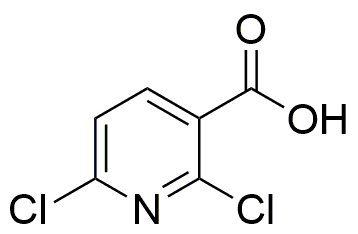2,6-Dichloronicotinic acid is widely utilized in research focused on:
- Agricultural Chemistry: This compound serves as an important intermediate in the synthesis of herbicides, helping to develop more effective weed control solutions in crop management.
- Pharmaceutical Development: It plays a role in the synthesis of various pharmaceutical agents, particularly in the development of drugs targeting neurological disorders, enhancing therapeutic options for patients.
- Material Science: Utilized in the creation of advanced materials, it contributes to the development of polymers and coatings with improved properties, such as durability and resistance to environmental factors.
- Analytical Chemistry: This compound is used as a standard in analytical methods, aiding researchers in the accurate quantification of related substances in complex mixtures.
- Organic Synthesis: It acts as a building block in organic synthesis, allowing chemists to create a variety of complex molecules efficiently, which can lead to innovations in multiple fields.
General Information
Properties
Safety and Regulations
Applications
2,6-Dichloronicotinic acid is widely utilized in research focused on:
- Agricultural Chemistry: This compound serves as an important intermediate in the synthesis of herbicides, helping to develop more effective weed control solutions in crop management.
- Pharmaceutical Development: It plays a role in the synthesis of various pharmaceutical agents, particularly in the development of drugs targeting neurological disorders, enhancing therapeutic options for patients.
- Material Science: Utilized in the creation of advanced materials, it contributes to the development of polymers and coatings with improved properties, such as durability and resistance to environmental factors.
- Analytical Chemistry: This compound is used as a standard in analytical methods, aiding researchers in the accurate quantification of related substances in complex mixtures.
- Organic Synthesis: It acts as a building block in organic synthesis, allowing chemists to create a variety of complex molecules efficiently, which can lead to innovations in multiple fields.
Documents
Safety Data Sheets (SDS)
The SDS provides comprehensive safety information on handling, storage, and disposal of the product.
Product Specification (PS)
The PS provides a comprehensive breakdown of the product’s properties, including chemical composition, physical state, purity, and storage requirements. It also details acceptable quality ranges and the product's intended applications.
Certificates of Analysis (COA)
Search for Certificates of Analysis (COA) by entering the products Lot Number. Lot and Batch Numbers can be found on a product’s label following the words ‘Lot’ or ‘Batch’.
Numéro de catalogue
Numéro de lot/série
Certificates Of Origin (COO)
This COO confirms the country where the product was manufactured, and also details the materials and components used in it and whether it is derived from natural, synthetic, or other specific sources. This certificate may be required for customs, trade, and regulatory compliance.
Numéro de catalogue
Numéro de lot/série
Safety Data Sheets (SDS)
The SDS provides comprehensive safety information on handling, storage, and disposal of the product.
DownloadProduct Specification (PS)
The PS provides a comprehensive breakdown of the product’s properties, including chemical composition, physical state, purity, and storage requirements. It also details acceptable quality ranges and the product's intended applications.
DownloadCertificates of Analysis (COA)
Search for Certificates of Analysis (COA) by entering the products Lot Number. Lot and Batch Numbers can be found on a product’s label following the words ‘Lot’ or ‘Batch’.
Numéro de catalogue
Numéro de lot/série
Certificates Of Origin (COO)
This COO confirms the country where the product was manufactured, and also details the materials and components used in it and whether it is derived from natural, synthetic, or other specific sources. This certificate may be required for customs, trade, and regulatory compliance.


